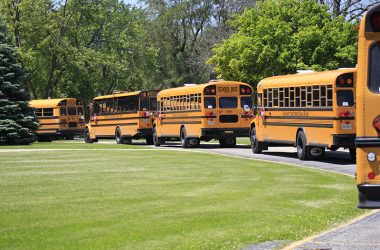Homewood-Flossmoor High School teacher Gina Slusinski sees museums as teaching labs, and her interest and curiosity have given her numerous hands-on experiences that she brings to her science classroom.

Gina Slusinski is being
considered for a national
award for her work at
H-F High School. (Photo by
Marilyn Thomas/HF Chronicle)
Slusinski’s approach to teaching has led to her being named one of five top science teachers in Illinois and is now being considered for the national Presidential Award for Excellence in Math and Science Teaching. She also has been nominated for a Golden Apple Award, a highly prized honor for outstanding teaching in Illinois.
“I do like experiential learning, so as much as I can I take students out of the classroom either on (the H-F) campus to do field studies…or field trips, as many as I can throughout the year, just to practice what we’ve learned in class and to give them real-life experience seeing things and understanding them,” she said.
Slusinski recently was awarded a scholarship from the Field Museum of Natural History that allowed her to bring 35 H-F biology students to the museum for a “Mapping the Tree of Life” program. The two-hour session helped students learn about how DNA analysis has changed our understanding of the relatedness of life on earth, as well as conduct a DNA extraction lab and meet with a scientist in the DNA Discovery Center.
Slusinski has been on the H-F teaching staff since 2003. She helped design the environmental science course at H-F and taught it for many years. This year she is teaching freshman biology and the zoology/botany class.
“As a teacher we want to develop those thinking skills and deductive reasoning skills,” Slusinski said. “That’s really my big overarching theme: to have the students think about things in another way, question, come up with their own questions and then even try to answer their questions with guidance from me, but not necessarily always telling them. “
For example, in teaching about human cells, she asked students to consider them as the body’s factory. This helped them understand how cell makeup works as a unit and how they interact within the body. She used the factory analogy to help students relate to how cohesive units work and benefit from each individual action.
Slusinski is a recognized teacher leader at the Field Museum in Chicago and has served as a Field Ambassador the past seven years, but she doesn’t restrict museum learning to just one place. Zoos, botanical gardens, nature preserves—they all qualify as places for excellent learning opportunities.
Slusinski is so passionate about the opportunities that she is now a doctoral candidate at the Illinois Institute of Technology. Her major is science education and her dissertation is on “the use of inquiry-based and object-based instruction; learning and teaching in museums.”
The Field Ambassador position allows her into special areas of the museum and gives her access to objects on loan for use in her classroom. As part of her biology classes this semester, she recently borrowed skunk and white rabbit specimens from the Field. She also borrowed Native American artifacts for use by an H-F English teacher whose class was reading a story about Native Americans in the Northwest.
“I know the Field like the back of my hand just from going there as a little kid all the time. I find a lot of kids (today) are fascinated by the (Field) objects,” she said. “They love looking at these things.”
In summer 2015, Slusinski was named to an eight-member teacher advisory board that’s planning a lesson around the Field’s new permanent exhibition, the Cyrus Tang Hall of China, that includes textiles, rubbings, bronzes, ceramics and sculpture.
“We’ve been working on this lesson for the last several months which hopefully we should be able to have published sometime in January,” she said. “Some of the lesson will be put online for teachers. They’re also putting up images of the objects in the exhibit, so even if you can’t get to the museum you can still see the objects there.”
From objects hundreds of years old “you could learn a lot about today and where we’re headed,” she tells her students.
In 2011, the Field selected Slusinski as one of two dozen curriculum specialists who worked for a year designing a new Systems Biology Program for teachers. They presented the program at a 2012 week-long summer workshop for teachers whose feedback helped Slusinski and other committee members refine the lessons that today are online for teacher use.


